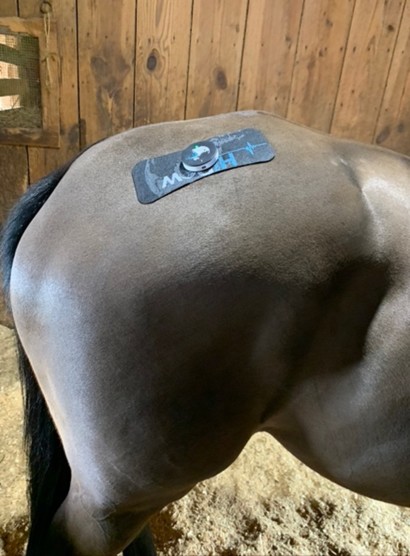Electro-Stimulation Therapy for Horses
Updated March 29, 2024 | By: Andris J. Kaneps, DVM, PhD, DACVS, DACVSR

Electro-stimulation (or e-stim) is not to be confused with electroshock therapy which is key to getting an irregular heartbeat back on track! Instead, electro-stimulation involves low-level electrical currents to stimulate nerves and muscles. The level of energy for these therapies is very low and is not painful for humans or horses.
While there are various types of electro-stimulation therapies for horses (such as galvanic stimulators, microcurrent, and electroacupuncture) we’ll discuss two types of muscle stimulation and one type of nerve stimulation.
Electro-stimulation must be administered by a trained practitioner, such as your supervising veterinarian or equine rehabilitation therapist.
Neuromuscular Electrical Stimulation (NMES) for Horses
Neuromuscular electrical stimulation (NMES) uses specific electrical impulses to activate muscle groups. The activation of muscle works by boosting strength, reducing the negative effects of being laid-up, and improving range of motion. NMES treatments reduce muscle spasms and pain, while also increasing blood flow to the muscle.
NMES is applied with small electrode pads that are placed over the target muscles. A compact control unit (usually smaller than a cell phone) is used to adjust the waveform, strength of impulse, and time of the treatment.
Functional Electrical Stimulation (FES) for Horses
Functional Electrical Stimulation (FES) is a type of NMES that specifically stimulates motor and sensory nerves. FES is used to block pain and improve muscle function.
FES mimics the body’s own rhythmic muscle contractions by sending electrical impulses in a similar pattern as the body would. This type of treatment results in deeper muscle contractures than NMES.
These controlled muscular contractions can mobilize muscles, tendons, and ligaments which is key to the rehabilitation process. FES is useful in activating injured or stiff muscles and preventing atrophy, as well as preventing muscle spasms.
FES is applied using large pads which contain the electrodes that stimulate the muscle groups. Professionals operate FES by using a larger control unit which contains a computer used to generate complex waveforms. Sessions require 30-90 minutes and are repeated depending on your veterinarian’s treatment plan for your horse.
Research on Neuromuscular Electrical Stimulation Effects in Horses
Research regarding the effects of neuromuscular electrical stimulation in horses has found:
- Measurable movement of the lumbosacral region during FES treatment, but not as much movement as with manual stimulation
[1]. - NMES therapy increases the cross-sectional area of the multifidus muscles, which are major stabilizing muscles of the back, more than manual dynamic mobilization exercises. Both therapies resulted in significant increases in multifidus size following 7 weeks of therapy
[2]. - In a retrospective study of 241 horses with topline muscle spasm treated with FES, 80% had at least one grade of improvement in spasms and 60% had continued effects for at least 2 months
[3].
Benefits of E-stim on Horses
- Prevent muscle atrophy and strengthen weak or injured muscles
- Re-educate muscle memory
- Relaxation of muscle spasm
- May increase range of motion
- Increase local blood circulation and reduce edema
Examples of When E-stim is Used on Horses
- To improve range of motion and joint mobility following an injury or imbalance
- As part of a rehab program to help a laid-up horse maintain muscle mass
- To help “re-train” a muscle to function normally and maintain that functional state
Transcutaneous Electrical Nerve Stimulation (TENS) for Horses
While not commonly used in horses, TENS is an electrical-stimulation therapy used to reduce pain sensation. The TENS unit sends a low voltage electrical current to partially block the pathway of pain signals from the sensory nerve fibers.
TENS may also stimulate the production of endorphins, our feel-good hormones that are the body’s natural painkillers. The full scientific understanding of how exactly TENS works continues to evolve today.
The TENS unit is very portable and can look a lot like an NMES unit. They’re usually small and battery-operated. The unit sends a low-level electrical impulse through its cords to electrode patches on the horse’s skin. The sticky patches are placed at or around the area being treated or on trigger points.
Benefits of TENS on Horses
- Pain relief
- Releases endorphins (feel-good hormones)
How Equine TENS is Used
- Sessions can last from 5 – 30 minutes with varying levels of intensity
- Horses may need a few sessions to get used to the feeling before they can relax during treatment
Examples of When TENS is Used on Horses
- Helping to relax tight muscles before a training session
- As a treatment for chronic pain
- Used for electroacupuncture by placing pads strategically to trigger acupressure points
Differences Between NMES/FES and TENS
NMES and FES have been found to stimulate motor and sensory nerves through electrical impulse contractions and the relaxation of muscles. While TENS stimulates only sensory nerves by blocking pain signals.
References
- Riedler and Licka. J Equine Vet Sci 2020
- Lucas, et al. J Equine Vet Sci 2022
- Schils and Turner. Comp Exercise Physiology 2014